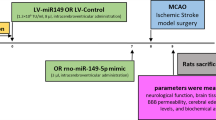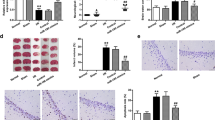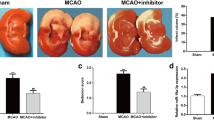Abstract
Stroke is one of the leading causes of death in the world, but the underlying molecular mechanism of this disease remains elusive, thus it will be great challenges to finding appropriate protection. MicroRNAs are short, single-stranded, non-coding RNAs and recent studies have shown that they are aberrantly expressed in ischemic condition. Due to the fact that miR-1 has harmful effects on neural damages during brain ischemia, limited miR-1 has been proven to be protective in middle cerebral artery occlusion (MCAO). Here, the possible positive effect of intravenous injection of antagomiR-1 as a post-ischemic treatment on neurological deficits, infarct volume, brain edema and blood–brain barrier (BBB) permeability was evaluated. The rats were divided randomly into three experimental groups, each with 21 animals. MCAO surgery was performed on all groups and one hour later, 0.1 ml normal saline, 0.1 ml rapamycin and 300 pmol/g miR-1 antagomir (soluble in 0.1 ml normal saline), were injected intravenously into control, positive control and treatment group, respectively. After 24 h, neurologic deficits score, infarct volume, brain edema and BBB permeability were measured. The results indicated that post-treatment with miR-1 antagomir significantly improved neurological deficits and reduced infarction volume, brain edema, and BBB permeability. These data proved that there is a positive effects of antagomiR-1 on ischemic neuronal injury and neurological impairment. Due to the fact that microRNAs are able to protect the brain, it would be a promising therapeutic approach to stroke treatment.




Similar content being viewed by others
References
Sandercock P, Berge E, Dennis M, Forbes J, Hand P, Kwan J, Lewis S, Lindley R, Neilson A, Wardlaw J (2004) Cost-effectiveness of thrombolysis with recombinant tissue plasminogen activator for acute ischemic stroke assessed by a model based on UK NHS costs. Stroke 35(6):1490–1497
Thomalla G, Sobesky J, Köhrmann M, Fiebach JB, Fiehler J, Weber OZ, Kruetzelmann A, Kucinski T, Rosenkranz M, Röther J, Schellinger PD (2007) Two tales: hemorrhagic transformation but not pa.renchyml hemorrhage after thrombolysis is related to severity and duration of ischemia-MRI study of acute stroke patients treated with intravenous tissue plasminogen activator within 6 hours. Stroke 38(2):313–318
Christensen M, Schratt GM (2009) MicroRNA involvement in developmental and functional aspects of the nervous system and in neurological diseases. Neurosci Lett 466(2):55–62
Blakeley JO, Llinas RH (2007) Thrombolytic therapy for acute ischemic stroke. J Neurol Sci 261:55–62
Xu L, Ouyang Y, Xiong X, Stary CM, Giffard RG (2015) Post-stroke treatment with miR-181 antagomir reduces injury and improves long-term behavioral recovery in mice after focal cerebral ischemia. Exp Neurol 264:1–7
Negrini M, Nicoloso MS, Calin GA (2009) MicroRNAs and cancer—new paradigms in molecular oncology. Curr Opin Cell Biol 21:470–479
Zhao Y, Ransom JF, Li A, Vedantham V, Drehle MV, Muth AN, Tsuchihashi T, McManus MT, Schwartz RJ, Srivastava D (2007) Dysregulation of cardiogenesis, cardiac conduction, and cell cycle in mice lacking miRNA12. Cell 129:303317
Carleton M, Cleary MA, Linsley PS (2007) MicroRNAs and cell cycle regulation. Cell Cycle 6:21272132
Yang Y, Sandhu HK, Zhi F, Hua F, Wu M, Xia Y (2015) Effects of hypoxia and ischemia on microRNAs in the brain. Curr Med Chem 22(10):1292–1301
Jeyaseelan K, Lim KM, Armugam A (2008) MicroRNA expression in the blood and brain of rats subjected to transient focal ischemia by middle cerebral artery occlusion. Stroke 39(3):959–966
Calin GA, Croce CM (2006) MicroRNA signatures in human cancers. Nat Rev Cancer 6(11):857–866
Hernando E (2007) microRNAs and cancer: role in tumorigenesis, patient classification and therapy. Clin Transl Oncol 9(3):155–160
Liu DZ, Tian Y, Ander BP, Xu H, Stamova BS, Zhan X, Turner RG (2010) Brain and blood microRNA expression profiling of ischemic stroke, intracerebral hemorrhage, and kainate seizures. J Cereb Blood Flow Metab 30:92–101
Chen JF, Mandel EM, Thomson JM, Wu Q, Callis TE, Hammond SM, Conlon FL, Wang D (2006) The role of microRNA-1 and microRNA-133 in skeletal muscle proliferation and differentiation. Nat Genet 38:228–233
Varendi K, Kumar A, Härma M, Andressoo J (2014) miR-1, miR-10b, miR-155, and miR-191 are novel regulators of BDNF.Cell. Mol. Life Sci 71:4443–4456
Miura P, Amirouche A, Clow C, Belanger G, Jasmin B (2012) Brain-derived neurotrophic factor expression is repressed during myogenic differentiation by miR-206. J Neurochem 120:230–238
Timmusk T, Persson H, Metsis M (1994) Analysis of transcriptional initiation and translatability of brain-derived neurotrophic factor mRNAs in the rat brain. Neurosci Lett 177:27–31
Jeyaseelan K, Lim KY, Armugam A (2008) MicroRNA expression in the blood and brain of rats subjected to transient focal ischemia by middle cerebral artery occlusion. Stroke 39:959–966
Shan ZX, Lin QX, Fu YH, Deng CY, Zhou ZL, Zhu JN, Liu XY, Zhang YY, Li Y, Lin SG, Yu XY (2009) Upregulated expression of miR-1/miR-206 in a rat model of myocardial infarction. Biochem Biophys Res Commun 381:597–601
Selvamani A, Sathyan P, Miranda RC, Sohrabji F (2012) Anantagomir to microRNA let7f promotes neuroprotection in an ischemic stroke model. PLoS ONE 7(2):e32662
Zhang Y, Zhang L, Chu W, Wang B, Zhang J, Zhao M, Li X, Li B, Lu Y, Yang B, Shan H (2010) Tanshinone IIA inhibits miR-1 expression through p38 MAPK signal pathway in post-infarction rat cardiomyocytes. Cell Physiol Biochem 26:991–998
Chang CHY, Lui TN, Lin JY, Lin YL, Hsing CH, Wang JJ, Chen RM (2016) Roles of microRNA1 in hypoxiainduced apoptotic insults to neuronal cells. Arch Toxicol 90(1):191–202
Erlich S, Alexandrovich A, Shohami E, Pinkas-Kermarski R (2007) Rapamycin is a neuroprotective treatment for traumatic brain injury. Neurobiol Dis 26:86–93
Santos RX, Correia SC, Cardoso S, Carvalho C, Santos MS, Moreira PI (2011) Effects of rapamycin and TOR on aging and memory: implications for Alzheimer’s disease. J Neurochem 117:927–936
Malagelada C, Jin ZH, Jackson-Lewis V, Przedborski S, Greene LA (2010) Rapamycin protects against neuron death in vitro and in vivo models of Parkinson’s disease. J Neurosci 30:1166–1175
Krutzfeldt J, Rajewsky N, Braich R, Rajeev KG, Tuschl Th, Manoharan M, Stoffle M (2005) Silencing of microRNAs in vivo with ‘antagomirs’. Nature 438:685–689
Bigdeli MR, Sohrab Hajizadeh S, Froozandeh M, Heidarianpour A, Rasoulian B, Asgari AR, Pourkhalili KH, Khoshbaten A (2008) Normobaric hyperoxia induces ischemic tolerance and upregulation of glutamate transporters in the rat brain and serum TNF-α level. Exp Neurol 212:298–306
Longa EZ, Weinstein PR, Carlson S, Cummins R (1989) Reversible middle cerebral artery occlusion without craniectomy in rats. Stroke 20:84–91
Liu P, Zhang R, Liu D, Wang J, Yuan Ch, Zhao X, Li Y, Ji X, Chi T, Zou L (2018) Time-course investigation of blood–brain barrier permeability and tight junction protein changes in a rat model of permanent focal ischemia. J Physiol Sci 68(2):121–127
Bigdeli MR, Hajizadeha S, Froozandeh M, Rasoulian B, Heidarianpour A, Khoshbaten A (2007) Prolonged and intermittent normobaric hyperoxia induce different degrees of ischemic tolerance in rat brain tissue. Brain Res 1152:228–233
Aboutaleb N, Shamsaei N, Khaksari M, Erfani S, Rajabi H, Nikbakht F (2015) Pre-ischemic exercise reduces apoptosis in hippocampal CA3 cells after cerebral ischemia by modulation of the Bax/Bcl-2 proteins ratio and prevention of caspase-3 activation. J Physiol Sci 65(5):435–443
Yin KJ, Hamblin M, Chen YE (2014) Non-coding RNAs in cerebral endothelial pathophysiology: emerging roles in stroke. Neurochem Int 77:9–16
Kim VN, Han J, Siomi MC (2009) Biogenesis of small RNAs in animals. Nat Rev Mol Cell Biol 10:126–139
Williams AE (2008) Functional aspects of animal microRNAs. Cell Mol Life Sci 65:545–562
Dharap A, Bowen K, Place R, Li L, Vemoganti R (2009) Transient focal ischemia induces extensive temporal changes in rat cerebral microRNAome. J Cereb Blood Flow Metab 29:675–687
Liu DZ, Tian Y, Ander BP, XU H, Stamova BH, Zhan X, Turner RJ, Jickling G, Sharp FR (2010) Brain and blood microRNA expression profiling of ischemic stroke, intracerebral hemorrhage, and kainate seizures. J Cereb Blood Flow Metab 30:92–101
Lee YJ, Johnson KR, Hallenbeck JM, Meuth SG (2012) Global protein conjugation by ubiquitin-like-modifiers during ischemic stress is regulated by microRNAs and confers robust tolerance to ischemia. PLoS ONE 7(10):e47787
Li D, Liu Y (2015) MicroRNA-1 promotes apoptosis of hepatocarcinoma cells by targeting apoptosis inhibitor-5 (API-5). FEBS Lett 589:68–76
Tang Y, Zheng J, Sun Y, Wu Z, Liu Zh, Huang G (2009) MicroRNA-1 regulates cardiomyocyte apoptosis by targeting Bcl-2. Int Heart J 50:377–387
Okouchi M, Ekshyyan O, Maracine M, Aw TY (2007) Neuronal apoptosis in neurodegeneration. Antioxid Redox Signal 9:1059–1096
Jana A, Hogan EL, Pahan K (2009) Ceramide and neurodegeneration: susceptibility of neurons and oligodendrocytes to cell damage and death. J Neurol Sci 278:5–15
Tang Y, Zheng J, Sun Y, Liu Zh, Huang G (2009) MicroRNA-1 regulates cardiomyocyte apoptosis by targeting Bcl-2. Int Heart J 50(3):377–387
Adair JC, Knoefel JE, Morgan N (2001) Controlled trial of N acetylcysteine for patients with probable Alzheimer’s disease. Neurology 57:1515–1517
Acknowledgements
This work was performed as a PhD project supported financially by Department of Biology of Islamic Azad University-Zanjan, Faculty of life Sciences and biotechnology of Shahid Beheshti University, and Council for Stem Cell Sciences and Technologies. We also thank Dr Salma Ahmadloo for reviewing our research paper.
Author information
Authors and Affiliations
Corresponding author
Ethics declarations
Conflict of interest
The authors declare that they have no conflicts of interest.
Ethical approval
All the international, national, and/or institutional applicable guidelines for the care and use of animals were followed. All the animal procedures performed in this research were in accordance with the ethical standards of the institution at which the study was conducted. This article does not contain any studies performed on human participants by any of the authors.
Additional information
Publisher’s Note
Springer Nature remains neutral with regard to jurisdictional claims in published maps and institutional affiliations.
Rights and permissions
About this article
Cite this article
Talebi, A., Rahnema, M. & Bigdeli, M.R. Effect of intravenous injection of antagomiR-1 on brain ischemia. Mol Biol Rep 46, 1149–1155 (2019). https://doi.org/10.1007/s11033-018-04580-y
Received:
Accepted:
Published:
Issue Date:
DOI: https://doi.org/10.1007/s11033-018-04580-y




